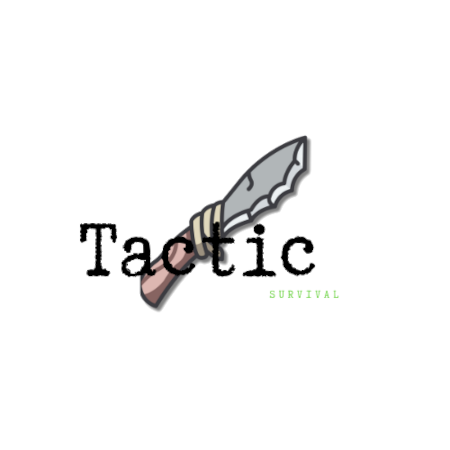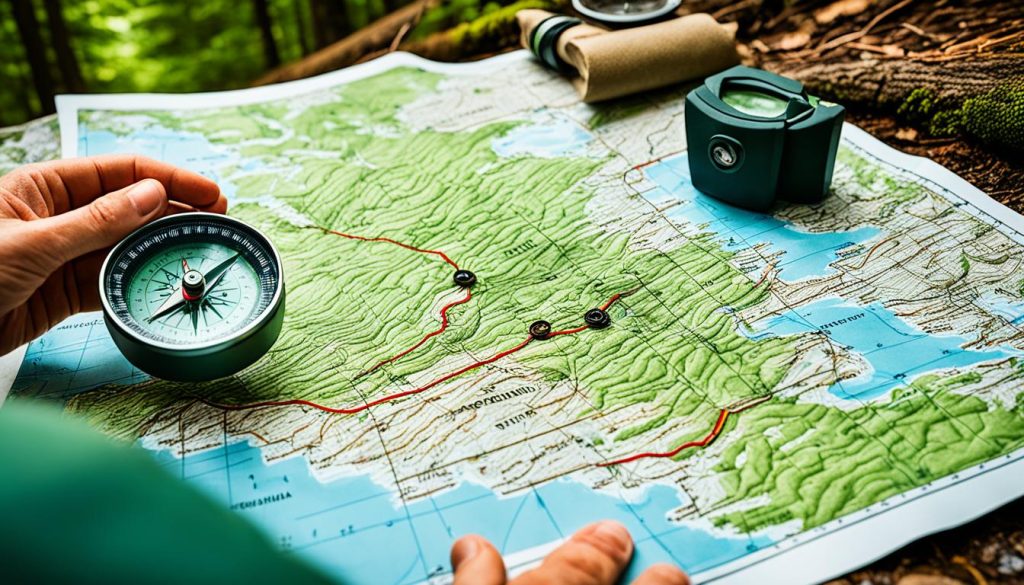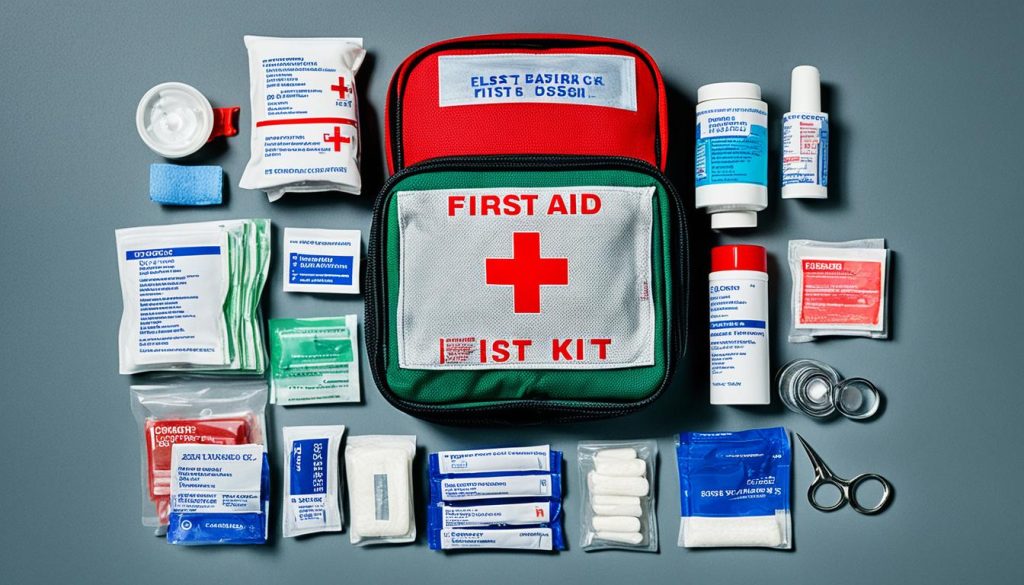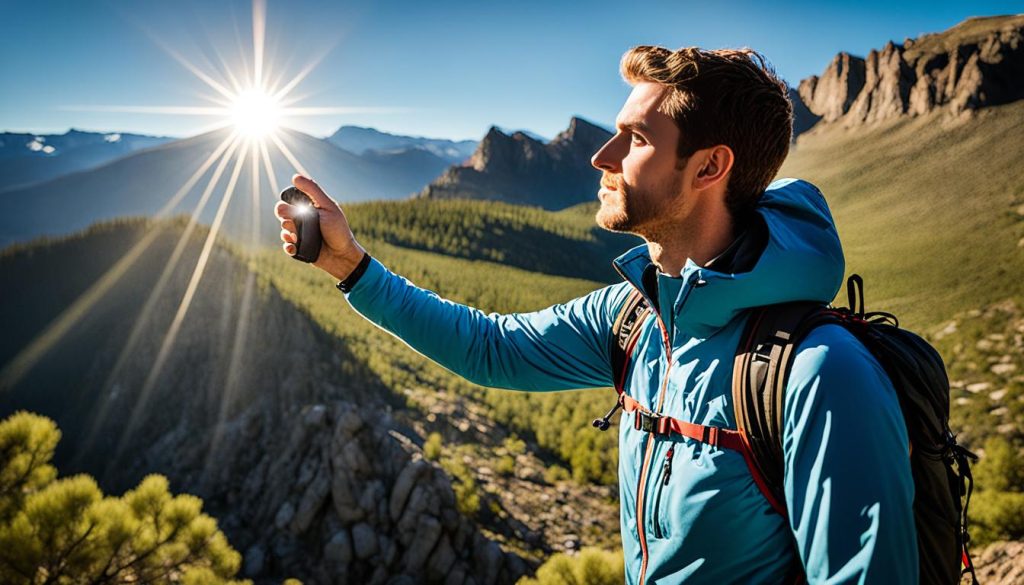Did you know that over 2,000 search-and-rescue missions are conducted each year in the United States alone?
When venturing into the great outdoors, it’s crucial to be prepared for any situation. One of the most important aspects of wilderness survival is having the right navigational tools to help you find your way and navigate through unfamiliar terrain. Whether you’re an experienced hiker or a novice explorer, these tools can mean the difference between a safe adventure and a dangerous situation.
Key Takeaways:
- Having the right navigational tools can make a significant difference in your wilderness survival.
- Top tools include maps and compasses, GPS devices, signal mirrors, fire starters, water purification systems, and a reliable knife.
- Investing time in learning essential map and compass skills is crucial for your safety.
- Regularly maintaining and updating your survival kit is essential for preparedness.
- Practice your navigation skills and familiarize yourself with the tools before heading into the wild.
Map & Compass
Pack a reliable map and compass in your wilderness survival kit to navigate with confidence. While GPS technology can be helpful, it’s important to have a backup in case of battery failure or signal loss in remote areas. Learning how to use a map and compass effectively is a crucial skill for wilderness navigation.
Using a compass comparison chart, choose a compass that suits your needs and preferences. Consider factors such as accuracy, durability, and ease of use. Look for features like adjustable declination, sighting mirror, and luminescent markings for nighttime navigation.
Take the time to learn how to use a map and compass properly. Familiarize yourself with basic compass terminology and functions, such as reading bearing and orienting the map. Practice using a compass alongside a map to determine your location, plot a route, and navigate challenging terrain.
“A well-used map and compass can be the most important pieces of equipment in your pack.”
— Rich Johnson
Benefits of Using a Map and Compass
- Precise Navigation: A map and compass allow you to navigate with accuracy, giving you confidence in finding your way.
- Offline Reliability: Unlike GPS devices that rely on satellite signals, a map and compass can function without batteries or network coverage.
- Enhanced Orientation: By using a compass in conjunction with a map, you can determine your current location and the direction in which you need to travel.
- Self-Sufficiency: Developing map and compass skills fosters self-reliance and the ability to navigate even in challenging situations.
| Map and Compass | Pros | Cons |
|---|---|---|
| Map |
|
|
| Compass |
|
|
First-Aid Kit
In addition to navigational tools, having a well-stocked first-aid kit is crucial for your wilderness survival gear. This kit should include various items to address minor injuries and potentially save lives in emergency situations.
Essential First-Aid Kit Items
- Bandages: These are essential for covering and protecting wounds, helping to prevent infection.
- Antibacterial Ointment: Applying antibacterial ointment to cuts and scrapes helps kill bacteria and promote healing.
- Triangle Bandages: These versatile bandages can be used to immobilize broken bones, create slings, or secure dressings.
- Gauze for Compression: Gauze is crucial for applying pressure to wounds to control bleeding in emergency situations.
Having these items in your first-aid kit ensures that you are prepared to handle common injuries and emergencies during your wilderness adventures.
Example First-Aid Kit:
| Item | Quantity |
|---|---|
| Bandages | Assorted sizes and types |
| Antibacterial Ointment | 1 tube |
| Triangle Bandages | 2 |
| Gauze for Compression | 3 rolls |
| Plastic Gloves | 1 pair |
| Tweezers | 1 pair |
| Scissors | 1 pair |
| Antiseptic Wipes | 10 |
| Pain Relievers | As needed |
| Emergency Blanket | 1 |
Remember to periodically check the expiration dates of the items in your first-aid kit and replace any expired or used supplies. Additionally, it’s important to familiarize yourself with basic first-aid techniques and seek proper training to confidently handle medical emergencies in the wilderness.
Signal Mirror
A signal mirror is a valuable tool for wilderness survival. When you find yourself lost or in need of help, a signal mirror can be used to attract the attention of first responders, increasing your chances of being rescued quickly and efficiently. This compact and lightweight device is an essential addition to your navigation tools, as it can provide a visual signal over long distances.
One of the advantages of a signal mirror is its reflective surface, which is specifically designed to produce a bright and visible flash of light when aimed correctly. By reflecting sunlight towards a specific target, such as passing aircraft or search and rescue teams, you can effectively communicate your need for assistance. The flash of light created by the mirror is extremely noticeable, especially against contrasting backgrounds. This means that even in remote and challenging terrains, the attention of first responders can be easily captured.
Signal mirrors are often included in compass designs, allowing for dual functionality and convenience. This means that with just one tool, you can both navigate your way through the wilderness and signal for help when necessary. The integration of a mirror into a compass ensures that you have a reliable signaling device readily available, without the need for additional weight or space in your survival kit.
When using a signal mirror, remember to aim the reflection directly at the intended target, ensuring the mirror is held as flat as possible to maximize the reflection. By flashing the mirror multiple times and at regular intervals, you can increase the chances of catching the attention of first responders or other individuals who may be in the vicinity. It’s important to note that signaling with a mirror works best during daylight hours when the sun is high and visible.
Overall, a signal mirror is a simple yet effective tool that can greatly enhance your chances of survival in the wilderness. By utilizing its reflective properties, you can effectively communicate your need for help and draw attention to your location. Including a signal mirror in your wilderness survival kit is a smart decision that can potentially save your life in emergency situations.
Fire Starter
Starting a fire is crucial for survival in the wilderness, especially in cold temperatures. When you find yourself in an emergency situation, having the means to create a fire can provide warmth, light, and the ability to cook food. It can also serve as a signal to potential rescuers.
To ensure you have the best chance of starting a fire, it’s important to pack a few different types of fire starters in your wilderness survival kit. Here are some options:
- Matches: Waterproof matches are a reliable and convenient fire-starting tool. Make sure to store them in a waterproof container to keep them dry.
- Lighters: A reliable lighter is another essential fire starter. Opt for a windproof and waterproof lighter for optimal performance in outdoor conditions.
- Strikers: Ferrocerium fire starters, also known as strikers or firesteel, create sparks when struck against a hard surface. They are lightweight and can be used in various weather conditions.
- Dry tinder: Along with fire-starting devices, carry dry tinder to easily catch a flame. Dry leaves, twigs, or commercially available fire-starting tinder can be excellent options.
It’s important to have a reliable fire starter in waterproof packaging to protect it from moisture and ensure its functionality when you need it most.
Stay Safe and Warm
“In cold temperatures, a fire can mean the difference between life and death. The warmth it provides can help prevent hypothermia and keep you alive until help arrives. Having multiple fire-starting options increases your chances of success, even in challenging weather conditions.”
Practice creating fires using different fire-starting methods before venturing into the wilderness. This will give you the confidence and skills needed to start a fire efficiently when faced with a survival situation. Remember to always follow fire safety guidelines and ensure the fire is fully extinguished before leaving the area.
Comparison of Fire Starters
| Fire Starter | Pros | Cons |
|---|---|---|
| Matches | – Easy to use – Portable and lightweight |
– Prone to getting wet – Limited number of uses |
| Lighters | – Convenient and reliable – Long-lasting fuel |
– Can run out of fuel – Not suitable for extreme cold |
| Strikers | – Works in wet conditions – Generates high-temperature sparks |
– Requires practice to use effectively – May be less reliable in windy conditions |
| Dry tinder | – Easily ignites with sparks or flame – Lightweight and readily available in nature |
– Limited shelf life – Requires proper storage to stay dry |
Choosing the right fire starter for your wilderness adventures depends on various factors such as weather conditions, personal preference, and the level of convenience you require. Consider packing a combination of different fire starters to maximize your chances of successfully starting a fire when you need it most.
Water Purification System
Having access to clean drinking water is essential for wilderness survival. When venturing into the wild, it’s crucial to include a water purification system in your gear to ensure that you can safely drink water from natural sources. While natural water bodies may appear pristine, they can contain harmful bacteria, parasites, and viruses that can lead to waterborne illnesses.
One effective method of water purification is by using water purification tablets. These small tablets are compact, lightweight, and easy to carry, making them an ideal backup option in case your main purification system fails. Water purification tablets, such as Aquatabs, are designed to kill bacteria, viruses, and other pathogens present in the water, making it safe for consumption.
Water purification tablets are simple to use. Just follow the instructions provided by the manufacturer. Typically, you will need to dissolve one tablet in a specified amount of water, wait for the designated time, and the tablets will effectively disinfect the water, making it safe for drinking.
Remember, staying hydrated is crucial when spending time in the wilderness. Dehydration can lead to fatigue, confusion, and even life-threatening conditions. With a reliable water purification system in your survival kit, you can confidently replenish your water supply from nearby streams, lakes, or rivers during your outdoor adventures.
“A water purification system ensures that you have a source of clean drinking water, allowing you to survive and stay hydrated in the wilderness.”
– John Marshall, Outdoor Enthusiast
In addition to using a water purification system, it’s important to be aware of other water treatment methods, such as boiling or using a portable water filter. The Centers for Disease Control and Prevention provides comprehensive information on backcountry water treatment methods. For more details, visit https://www.cdc.gov/healthywater/drinking/travel/backcountry_water_treatment.html.
Choosing the Right Water Purification System
When selecting a water purification system, consider factors such as ease of use, weight, and effectiveness. Look for products that are specifically designed for outdoor use and have been tested for their ability to remove pathogens commonly found in wilderness water sources. Some popular options include portable water filters, ultraviolet (UV) light purifiers, and chemical treatments.
By prioritizing your hydration needs and investing in a reliable water purification system, you can ensure a safe and enjoyable wilderness experience while staying protected from waterborne illnesses.
Knife
A good knife is a versatile tool that can be a lifesaver in the wilderness. From cutting cord and bandages to sharpening sticks and skinning game, a reliable knife is an essential part of any survival kit. Its uses are only limited by your imagination and resourcefulness.
“A knife is one of the most important tools you can have in the wild. It serves multiple purposes, from basic tasks like cutting food to more critical ones like building shelter or starting a fire.” – Bear Grylls, outdoor survival expert
When choosing a survival knife, it’s important to consider its weight and sharpness. A lightweight knife, such as the Primus FieldChef Pocket Knife, is highly recommended as it won’t weigh you down during long hikes. Additionally, a sharp knife ensures precision and safety in various wilderness tasks.
Remember to keep your knife clean and sharp, as a well-maintained blade is more effective and safer to use. Proper care and maintenance will extend the lifespan of your knife, ensuring its usefulness for years to come. Whether you’re an experienced outdoorsman or a novice adventurer, a reliable survival knife should be an essential part of your wilderness gear.
Conclusion
In survival situations, having the right tools is crucial for your preparedness and well-being in the wilderness. Navigational tools, such as maps and compasses, are essential for finding your way and avoiding getting lost in challenging terrain. Additionally, tools like fire starters and water purification systems ensure your survival needs are met, including warmth and hydration.
To be fully prepared, it is important to customize your survival kit with these tools and regularly maintain them. This ensures that your gear is in optimal condition and ready to be used when needed. It is also essential to develop your wilderness navigation skills and practice using these tools beforehand. This way, you can confidently navigate through the wilderness and handle any emergency that arises.
Remember, being prepared is the key to staying safe in the wilderness. By having the right survival tools, being knowledgeable in wilderness navigation, and honing your survival skills, you can confidently enjoy your outdoor adventures while minimizing risks. Stay prepared, stay safe, and embrace the beauty and challenges of the wilderness.



